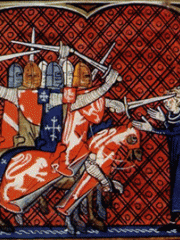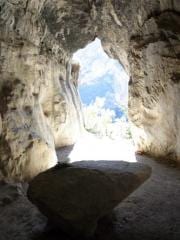Cathars
Отто Ран и Катары: между тайной и мошенничеством
Нашли ли нацисты чашу Грааля? Этот весьма каверзный и, казалось бы, праздный вопрос, однако, всерьез и весьма живо интересовал немецкий народ во время гитлеровского господства. Загадочная археологическая экспедиция, финансированная Третьим рейхом, отправилась на поиски драгоценного полумифического предмета во Францию, которую вскоре после этого оккупировали немцы – а точнее, в то самое место, на которое много веков назад пала легендарная тень катаров. Что же представлял из себя этот «исторический похода на самом деле?
Многие из тех, кто собирается углубиться в историю катаров, самой распространенной и жестоко подавленной ереси средневековой Европы, изучив источники этой подлинной религиозной революции, развернувшейся в Аквитании и на севере Италии, рано или поздно наткнутся на книгу, которая стала уже почти классикой для тех, кто изучает средневековье: «Крестовый поход за Граалем» немца Отто Рана.
Анэнэрбе – в поисках Грааля
Гитлер считал святой Грааль более древним, чем само христианство. Возможно, такое объяснение он придумал для того, чтобы разрешить логический спор в себе: между нетерпимостью к христианству и увлечением, наверно, самым известным его артефактом. Как бы там ни было, но Гитлер поручил Вирту (руководителю Аненербе ) найти Грааль.
Катары - поклонение Граалю
Отто Ран, человек, принявший активное участие в поисках Грааля. С детства увлекавшийся историей и верой Катаров, он считал, что Грааль находился у них.
Катары - еретическая секта, которая возникла в Южной Франции в XII веке. Катары считали, что в мире есть два начала, два бога - добрый и злой. Сотворение мира приписывалось именно злому богу. Катары отрицали христианскую атрибутику - крест, иконы, статуи, также катары не признавали таинств католической церкви. Отвергалось также существование рая и ада, а также учение о страшном суде. Катарами были разработаны собственные ритуалы, собственная система символов, одно из центральных мест в системе священных символов Катар занимал Грааль.
RELIGION: The Cathars and Otto Rahn
Ed Jajko says:_I would be most interested if Christopher Jones could cite his authorities for the Cathar Christology he presents us. What little I have read suggests that the Cathars had different, not entirely coherent views on Jesus Christ, but that they were not quite in consonance with what Mr. Jones has stated. Reference to a couple of scholarly sources would be much appreciated.
RH: Yes, a few precise sources.
Ed Jajko asked Christopher Jones to give sources for his statements about the Cathars. Christopher replies:
The sources for my comments on the Cathari are all from Cruzada contra el Grial [original German, Kreuzzug gegen dem Gral] by Otto Rahn. This particular translation was done by Fernando Acha and published by Hiperión in Madrid. To the best of my knowledge and a fact that was reconfirmed to me by the current copyright holder in Germany, Rahn's book was never translated into English although Spanish, French and Italian versions exist. The book was first published in 1933.
Croisade contre le Graal
Si le Graal est un symbole phare — aussi mystérieux que fascinant — de la mythologie et de l’inconscient collectif européens, Croisade contre le Graal appartient à la famille — peu nombreuse — des ouvrages mythiques, des livres cultes. Depuis sa parution (1933 en Allemagne, 1934 en France), il a guidé des générations de rêveurs vers les cimes ariégeoises, en général, et le château de Montségur, en particulier. Régulièrement réédité des deux côtés du Rhin, il est régulièrement épuisé et recherché. Adversaires et partisans des thèses développées par Otto Rahn, tous s’accordent sur un point: Croisade contre le Graal a largement contribué à l’engouement touristique pour les Pyrénées cathares.
What is the Grail?
The Grail. Between 1190 and 1240, it formed the central theme of a series of literary works that spoke of, and appealed to, a new social class, that of the knights and warriors and the adventures they encountered on their travels. In recent decades, it unleashed Indiana Jones on one of his death-defying treasure hunts and was the central ingredient of Dan Brown’s The Da Vinci Code, one of the biggest bestselling novels ever.
For Richard Barber, in The Holy Grail: The History of a legend, “it is, in all its forms, a construct of the creative imagination”. However, for dozens of other authors, the Grail is not a literary invention, but a veritable treasure, out there, somewhere. Unfortunately, in general, studies trying to identify and trace the physical Grail have taken on flights of fancy. The Grail has been linked with countries from the Middle East to America, as well as with the persecuted Cathars and even extra-terrestrial beings. It has been labelled a code word for the Ark of the Covenant, after the Templars allegedly transported it from the Middle East to a new hiding place in France.
The wooden book of Montségur
In the early 20th century, a series of palm leaves, containing anomalous writing, were apparently discovered within a hidden cache of the walls of the Cathar castle of Montségur. Though without any intrinsic value, the “wooden book” – as it became known – would become the centrepiece of the esoteric and metaphysical community; its discoverers even labelled it “the Oracle” and said it was able to contact the hidden masters of Agharta.
Montségur is seen as the final stronghold of the Cathar faith, a bastion of true devotion besieged by the worldly ambitions of the papal troops. In March 1244, the Cathars that had been locked inside the castle for months finally surrendered; approximately 220 were burned en masse in a bonfire at the foot of the pog when they refused to renounce their convictions.
Otto Rahn: A Hero's Journey
I recently visited the former South of France residence of the legendary Grail hunter Otto Rahn, only to discover that it was scheduled to be demolished, thus ending an era, and prompting this memorial.
I believe Otto Rahn (1904-1939) was a hero; the real Indiana Jones and prototype for Dan Brown’s Robert Langdon character. A tireless explorer, Rahn was a gifted researcher, committed to the quest like no one before, or since. Quite simply, he was a grail hunter extraordinaire.
Rahn was obsessed with the Cathars, and was convinced that their treasure remained hidden in the shadowy crevasses of the Pyrenees. His research led to Montségur, which he believed to be Munsalvaesche, the Mountain of Salvation of Wolfram von Eschenbach’s epic grail romance, Parzival. Not surprisingly, the entire region around Montségur soon became Rahn’s esoteric playground.
Otto Rahn's books
The first edition of Kreuzzug gegen den Gral (Crusade Against the Grail).
Verlag: Freiburg im Breisgau, Urban Verlag, (1933)
ASIN: B0067TR0RY
Dan McNeil: The Judas Apocalypse, and Interview with the author
On the eve of the Second World war, Dr. Gerhard Denninger, a German archeologist is approached by infamous Grail seeker Otto Rahn who tells him a fantastic story of Templars, Church scandal, a long-buried manuscript, and the key to finding the famous lost treasure of the Cathars. In 1944, with the help of a group of American soldiers, Denninger continues his quest for the secret of the Cathar treasure. With dangers dogging them at every step, will they find what they’re seeking? And will they be prepared for the shocking discovery that awaits them?
Himmler and Otto Rahn's Cathars
Once a faithful Roman Catholic, Heinrich Himmler rejected religion at about the time that a parliamentary decree robbed him of his aristocratic title. Stripped of both his faith and social status simultaneously, Himmler, like the fictional Dieter Bachman of The Blood Lance, threw himself passionately into the Nazi cause. At the same time he became interested in all aspects of the occult.
Himmler does not seem to have been an especially brilliant man but he was educated, sophisticated, and notoriously energetic. As the leader of the SS, he oversaw the activities of the Gestapo; he ran the concentration camps; he provided Hitler ultimately with twelve divisions of elite armoured troops, and he built a massive civilian organisation devoted to German culture. It oversimplifies matters to suggest the SS was Hitler's Praetorian Guard, with Himmler in the role of Tiberius' Prefect, Aelius Sejanus. Likewise, it misses much of the complexity of the SS to say they are like the Knights Templar of the Crusade era. The similarities between the two organisations are probably not accidental, but it was the civilian side of the SS that made the Order of the Skull Himmler's own creation. It was into the civilian branch of the SS that Himmler recruited Otto Rahn.











Comentarios recientes
hace 13 años 41 semanas
hace 13 años 42 semanas
hace 13 años 42 semanas
hace 13 años 42 semanas
hace 13 años 45 semanas
hace 13 años 51 semanas